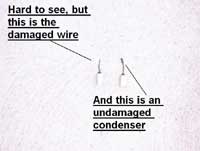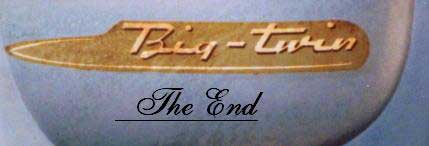The Big Twin's initial test run can be called a success;
the engine started easily and ran well. It was obviously too
much horsepower for the AF4, even with it's under-sized propeller.
Although I did not hook-up the tachometer, it seemed pretty
obvious that the engine could use a propeller with more more
pitch, which should increase the speed a bit.
 (click images to enlarge)
(click images to enlarge) |
I ran the engine with the tiller , and then coupled the AF4's
remote controls up to it, which only took a few minutes (one
of the reasons that I recommend these old OMCs). As I mentioned
way back in the column
concerning remote throttle and shift controls, there is a
friction disk underneath the throttle twist-grip throttle
that needs to be removed when remote controls are used with
these engines so as to avoid excessive loads on the controls.
I was unable to loosen the screw retaining the twist grip
with a screwdriver so decided to limit my test running and
work on the twist grip back at the shop, where my handy and
cheap impact driver (mentioned in the recoil starter
column) would make short work of the
reluctant screw.
Speaking of recoil starters, I will most likely replace the
rope on the Big Twin, and maybe the spring as well. It is
just so much better to do it at home than to have to deal
with a broken rope or spring on the water, possibly ruining
a too-infrequent day of boating.
Last Friday, while at work, I recieved a cell phone call from
a manager who I knew to be on vacation. My curiosity as to
why he would "call-in" on a vacation day was quickly
satisfied when he asked for the oil-mixing ratio for a late-model
Mercury 9.8 hp outboard.
About an hour later he called again. Now he was sitting in
the boat holding the broken end of the starter cord and wondering
what to do next.
How do you think his vacation day went?
Would having replaced a 50-cent piece of rope in advance
made an improvement?
A big part of the reason that the Big Twin, like the 5 1/2
featured in the first "Start to Finish' series, was easily
and cheaply "revived" involves the selection of
the engine; I feel it is best to avoid engines showing signs
of abuse, which includes make-shift repairs. Both of the "Start
to Finish" engines had all their knobs and screws and
parts, and neither had signs of slip-shod repairs. They had
few screw heads with
stripped slots and no missing screws,
They had been ignored but not neglected. That both engines
still had cracked coils indicated that they had seen little
use, and no use in recent years, as it did not take too many
years for these coils to start cracking.
Do not mistake a poorly-appearing engine for one that has
been abused, however. A really poor repaint job might hide
a very sound engine.
I again will suggest that a "cheap-power" seeker
begin his outboard education by attending some of the swap
meets sponsored by the Antigue Outboard Motor Club; their
swap meet schedule is posted online:
https://www.aomci.org/events/
These meets are an ideal way to learn about old outboards
and how to evaluate them. You will always find people there
who are ready, willing, and able to talk about old outbaords
just as much as you care to listen too.
Beyond the swap meets, I feel it is also a better idea to
purchase engines from private parties looking to rid their
garage / basement / storage shed of what they consider a nuisance,
rather than to deal with people who are trying to make their
living off of old engines. You are doing the former a favor
by hauling-off something that he might otherwise have to pay
to get rid of. Substitute his gratitude for your cash.
Back to the Big Twin; once I get around to looking at the
recoil starter, I will consider it to be a "runner,"
and other than normal maintainance and winterization, it should
require little more "wrenching"
Happy Motor'n


